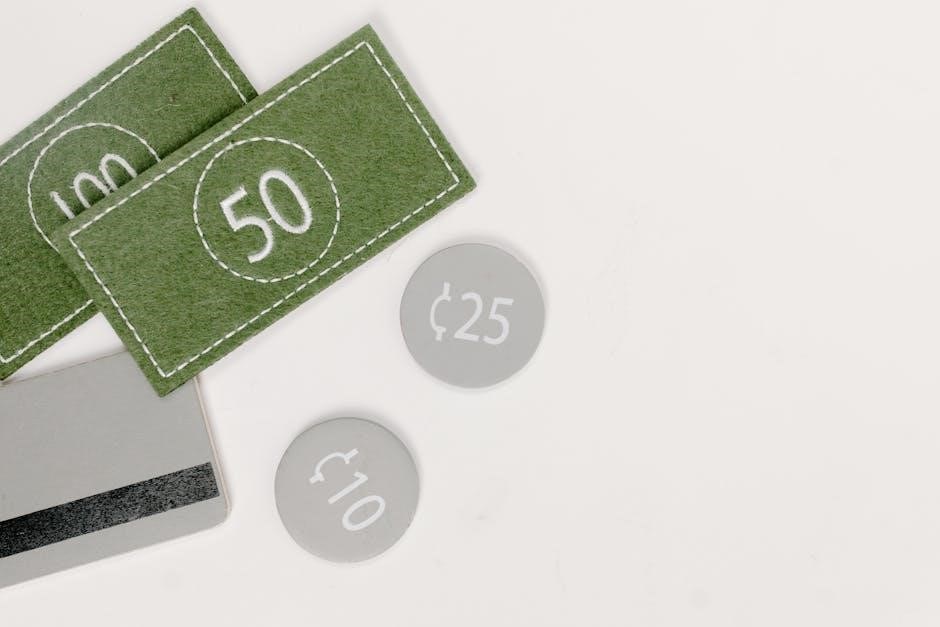Credit cards are essential tools for building financial literacy. Student-focused worksheets and lesson plans teach responsible usage‚ covering basics like APR‚ grace periods‚ and debt management strategies.
What Are Credit Cards?
Credit cards are financial tools that allow users to borrow funds up to a predefined limit for purchases‚ services‚ or cash advances. They function as a type of revolving credit‚ meaning the borrower can reuse the credit line after repaying the balance. Unlike debit cards‚ which draw directly from a bank account‚ credit cards enable users to pay later‚ with interest applied if balances aren’t paid in full. Key terms like APR (Annual Percentage Rate) and grace period are essential to understanding how credit cards work. APR is the interest rate applied to unpaid balances‚ while the grace period is the time allowed to pay off the balance without incurring interest. Responsible use of credit cards helps build credit history‚ making them a valuable tool for financial management when used wisely.
Why Credit Card Education Is Important for Students
Credit card education is crucial for students to understand financial responsibility and avoid debt. Many students receive their first credit card during college‚ making it vital to grasp how credit works. Without proper knowledge‚ students may accumulate high-interest debt or damage their credit scores. Education helps students differentiate between needs and wants‚ encouraging mindful spending habits. It also teaches them to compare cards‚ understand APR‚ and recognize the importance of paying balances in full. By learning these skills early‚ students can build a strong financial foundation‚ avoid costly mistakes‚ and develop healthy money management practices that benefit them throughout their lives. Early education fosters financial literacy and independence.
Understanding Credit Card Basics
Credit cards allow borrowers to purchase goods and services by borrowing funds. Responsible use requires understanding APR‚ grace periods‚ and fees to avoid debt and build credit wisely.
Key Terms: APR‚ Grace Period‚ Transaction Fees
Credit cards involve essential terms that students must understand to manage their finances effectively. APR (Annual Percentage Rate) refers to the interest rate applied to unpaid balances‚ affecting how much borrowers pay over time. The grace period is the timeframe during which no interest is charged if the full balance is paid by the due date. Transaction fees are charges for specific actions‚ such as foreign transactions‚ cash advances‚ or late payments. Understanding these terms helps students avoid unnecessary costs and use credit cards responsibly. These concepts are fundamental for building healthy financial habits and avoiding debt.
Revolving vs. Installment Credit
Credit cards fall under revolving credit‚ allowing users to borrow and repay funds repeatedly up to a set limit. This flexibility means the credit line remains available as debts are paid. In contrast‚ installment credit involves borrowing a fixed sum repaid in regular‚ fixed amounts over a predetermined period‚ such as personal loans or mortgages. Understanding the difference is crucial for managing credit effectively. Revolving credit requires discipline to avoid overspending‚ while installment credit provides structured repayment plans. Both play roles in financial management‚ but credit cards’ revolving nature demands careful use to prevent debt accumulation. This distinction is key for students learning to manage credit responsibly.

How to Shop for a Credit Card
Compare features‚ terms‚ and benefits to find the best card for your needs. Consider APR‚ fees‚ rewards‚ and credit limits. Use worksheets to evaluate options carefully.
Comparing Credit Card Features
When evaluating credit cards‚ focus on key features such as APR‚ grace periods‚ and transaction fees. Consider rewards programs‚ credit limits‚ and annual fees. Students should prioritize cards with low APRs and no annual fees‚ as these are more budget-friendly. Look for cards offering cashback or points on everyday purchases‚ which can provide value over time. Additionally‚ check for perks like purchase protection or travel insurance. Using comparison worksheets‚ students can side-by-side analyze cards to identify which aligns best with their spending habits and financial goals. This step ensures informed decisions and helps avoid costly mistakes.
Side-by-Side Analysis Worksheet
A side-by-side analysis worksheet enables students to compare credit card features effectively. Columns can be dedicated to APR‚ grace period‚ annual fee‚ rewards‚ and benefits. Rows represent different cards. Students research and fill in details for each card‚ highlighting pros and cons. This visual tool simplifies decision-making by showcasing similarities and differences. It encourages critical thinking about which card best suits their needs. The worksheet also includes sections for notes and final recommendations‚ guiding students to make informed choices. This practical exercise helps students develop essential financial literacy skills‚ preparing them for real-world credit decisions.

Understanding Credit Card Statements
Learning to read and interpret credit card statements is crucial for managing finances. Statements detail transactions‚ balances‚ due dates‚ fees‚ and rewards‚ aiding responsible credit use.
Reading Your Monthly Statement
Understanding your monthly credit card statement is vital for managing finances. Statements detail charges‚ balances‚ due dates‚ and fees. Reviewing each section helps track spending and ensure payments are made on time. Key areas include the statement period‚ total balance‚ minimum payment‚ and due date. Students should check for errors or unauthorized transactions. Regular review aids in budgeting and avoiding overspending. Understanding interest charges and rewards is also crucial. By analyzing statements‚ students can monitor their financial habits and make informed decisions. This practice fosters financial responsibility and helps avoid debt. Encourage students to use worksheets to practice reading and interpreting statements effectively.
Tracking Charges and Balances
Tracking charges and balances is crucial for managing credit card use. Students should regularly review their transactions to monitor spending habits and ensure accuracy. Logging purchases helps identify unnecessary expenses and prevents overspending. Checking balances frequently allows students to stay within their limits and avoid interest charges. Understanding how charges affect the overall balance fosters financial awareness. Worksheets can be used to practice tracking‚ helping students connect their purchases to their monthly statements. This habit encourages responsible credit card use and helps build a strong foundation for financial literacy. By staying informed‚ students can avoid debt and make smarter financial decisions. Regular tracking also helps detect any errors or unauthorized charges promptly.

Managing Credit Card Debt
Understanding interest rates and creating a budget are key to managing debt. Paying balances in full and avoiding unnecessary purchases help students maintain financial control and stability.
Understanding Interest Rates
Interest rates on credit cards determine the cost of borrowing. Calculated as a percentage‚ they apply to unpaid balances. For example‚ if you owe $427 with an 18% APR‚ interest accrues over time. Understanding how interest compounds helps students avoid debt. The formula I = P * r * t (interest = principal * rate * time) shows how balances grow. Higher APRs and longer payment periods increase total costs. Paying more than the minimum reduces interest over time. This knowledge empowers students to manage debt effectively and avoid financial strain. Workshops and worksheets simplify these concepts for better understanding.
Paying Off Balances: Tips and Strategies
Paying off credit card balances is crucial for avoiding debt. Start by paying more than the minimum payment each month to reduce principal faster. Use the snowball method: pay off smaller balances first for motivation. Prioritize high-interest cards to save on interest over time; Avoid new purchases while paying off debt. Consider consolidating balances to a lower-interest card. Use the 50/30/20 rule: 50% income for needs‚ 30% wants‚ 20% savings. Track spending with worksheets to stay accountable. Automate payments to ensure timely payments. Cut expenses and allocate extra funds to debt repayment. These strategies help students manage debt effectively and build healthier financial habits.

Credit Card Dos and Don’ts
Do pay balances in full monthly‚ avoid unnecessary purchases‚ and track charges. Don’t exceed credit limits‚ miss payments‚ or use cards for impulse buys or emergencies.
Best Practices for Credit Card Use
Using credit cards wisely starts with understanding their purpose as a financial tool. Always pay balances in full each month to avoid interest charges and
build a positive credit history. Set a budget and stick to it‚ ensuring purchases align with financial goals. Regularly review statements to catch errors
or unauthorized charges. Avoid using credit cards for impulse buys or non-essential items. Treat credit cards as a convenience‚ not a source of extra funds. By
following these practices‚ students can establish healthy financial habits early on‚ paving the way for long-term financial stability and independence.
Common Mistakes to Avoid
When using credit cards‚ students often make costly mistakes. One common error is treating credit cards as “free money‚” leading to overspending. Many students also fail to
understand APR and interest charges‚ which can accumulate quickly. Making only minimum payments is another pitfall‚ as it prolongs debt and increases total interest paid.
Missing payment due dates can harm credit scores and incur late fees. Additionally‚ ignoring monthly statements or not tracking purchases can lead to unauthorized charges or
budget overflows. Avoiding these mistakes requires discipline‚ awareness‚ and a clear understanding of credit card terms. By steering clear of these common errors‚ students can use credit
cards responsibly and build a strong financial foundation.

The 20-10 Rule for Credit Card Use
The 20-10 Rule helps students manage credit by limiting payments to 20% of income and paying balances within 10 months‚ avoiding excessive debt through practical worksheets.
What Is the 20-10 Rule?
The 20-10 Rule is a guideline for managing credit card use effectively. It suggests that no more than 20% of your income should go toward paying off credit card balances and other debt obligations. Additionally‚ the rule recommends paying off balances within 10 months to avoid long-term debt accumulation. This principle helps students prioritize financial responsibilities and avoid overspending. Worksheets and activities often incorporate this rule to teach practical money management skills‚ ensuring students understand the importance of maintaining healthy credit habits from an early age. By following the 20-10 Rule‚ students can build a strong foundation for financial stability and independence.
How to Apply It in Daily Life
Applying the 20-10 Rule in daily life involves practical steps to manage credit card use wisely. Students can start by tracking their income and expenses to ensure no more than 20% of their income goes toward debt. They should aim to pay off balances within 10 months to avoid prolonged debt. Worksheets and activities‚ such as budgeting exercises‚ help students visualize their financial commitments. Group discussions and real-life case studies also provide hands-on learning opportunities. By prioritizing needs over wants and setting realistic payment goals‚ students can adopt responsible credit card habits. Educators play a key role in guiding these practices through interactive lessons and scenario-based exercises.

Building Credit with a Student Credit Card
Student credit cards help establish credit history through responsible use. Worksheets guide tracking payments and balances‚ while secured cards or authorized user status provide additional credit-building opportunities for students.
How Credit Cards Affect Credit Scores
Credit cards significantly impact credit scores‚ as payment history and debt levels are key factors. Timely payments boost scores‚ while late payments or high balances harm them. Worksheets help students track credit utilization and understand how responsible use improves scores over time. Credit mix and history length also benefit from consistent‚ positive card use. Students learn how avoiding overspending and keeping credit utilization below 30% fosters a healthy credit profile. These habits lay the foundation for long-term financial health and higher credit scores‚ essential for future loans and financial opportunities.
Authorized Users and Secured Cards
Authorized users can be added to a primary cardholder’s account‚ allowing students to benefit from someone else’s good credit habits. This is a great way for students to build credit history without needing a full credit card. worksheets often include exercises to explore this option‚ such as calculating how being an authorized user impacts their credit score over time. Secured cards are another option for students‚ requiring a security deposit to open the account. These cards are designed for individuals with limited or no credit history‚ providing a safe way to establish credit responsibly.
Lesson Plan Activities
Interactive exercises‚ group discussions‚ and real-world case studies are effective activities that enhance students’ understanding of credit card management and financial literacy.
Shopping for Credit Cards Worksheet
This worksheet guides students in comparing credit card features‚ such as APR‚ fees‚ and rewards. They research and analyze two cards‚ identifying which suits different scenarios.
Students evaluate pros and cons‚ considering their financial goals. The exercise fosters critical thinking and decision-making skills‚ preparing them to choose a card wisely.
By completing this activity‚ students gain practical insights into credit card selection‚ helping them make informed financial decisions.
Group Discussions and Case Studies
Group discussions and case studies are interactive ways to engage students in learning about credit cards. These activities encourage critical thinking and collaboration.
Students analyze real-life scenarios‚ such as managing debt or choosing the right card‚ to understand financial consequences. Case studies provide practical examples of credit card use.
Group collaboration fosters teamwork and diverse perspectives‚ helping students grasp key concepts like APR and budgeting. These exercises prepare them for real-world financial decision-making.
By participating in these activities‚ students develop a deeper understanding of responsible credit card use and its impact on their financial future.

Credit Card Safety and Security
Protecting your credit card and information is crucial. Keep your card secure‚ monitor transactions‚ and report lost or stolen cards immediately to avoid financial loss.
Protecting Your Card and Information
Protecting your credit card and personal information is vital to prevent fraud and identity theft. Always keep your card in a safe place and never share your card details with unauthorized individuals. Be cautious when using public Wi-Fi or unsecured websites for transactions. Regularly monitor your account for unfamiliar charges and report any discrepancies immediately. Use strong‚ unique passwords for online accounts and enable two-factor authentication when possible. Avoid responding to unsolicited requests for your card information‚ as legitimate institutions will not ask for sensitive details via phone or email. Shred any documents containing your card information before disposal. If your card is lost or stolen‚ contact your issuer right away to block unauthorized use and request a replacement. These habits help safeguard your financial security and prevent potential damage to your credit score. Always stay vigilant and proactive in protecting your card and personal data.
What to Do If Your Card Is Lost or Stolen
If your credit card is lost or stolen‚ act quickly to protect your finances. Contact your credit card issuer immediately to report the incident and request the card be canceled. Most issuers have 24/7 customer service for such emergencies. Provide as much detail as possible about when and where the card went missing. Once reported‚ you are typically not liable for unauthorized charges. Monitor your account for any unfamiliar transactions and dispute them promptly. Request a replacement card with a new account number to ensure your information remains secure. Keeping a record of your communications with the issuer can also help resolve any issues faster. Acting swiftly minimizes potential fraud and safeguards your financial security.

Teaching Financial Responsibility
Educators play a crucial role in teaching financial literacy. Interactive activities like worksheets and real-life scenarios help students grasp essential skills such as budgeting‚ saving‚ and responsible spending habits.
Role of Educators in Credit Education
Educators play a vital role in shaping students’ understanding of credit card literacy. They can use worksheets and lesson plans to teach key concepts like APR‚ grace periods‚ and responsible spending. By incorporating real-life scenarios and interactive activities‚ teachers help students connect theoretical knowledge to practical decisions. Customizable lesson plans and educational videos provide educators with tools to engage students effectively. Encouraging group discussions and case studies fosters critical thinking and collaboration. Educators can also distribute worksheets like “Getting a Credit Card and Using It Wisely” to reinforce learning. Their guidance helps students develop healthy financial habits and a strong foundation for lifelong financial responsibility.
Engaging Students with Practical Exercises
Practical exercises are key to helping students grasp credit card concepts. Worksheets like “Shopping for Credit Cards” enable side-by-side comparisons‚ teaching students to evaluate features and costs. Activities such as calculating interest on purchases or determining affordable spending limits make learning interactive. Group discussions and case studies encourage collaboration and critical thinking. Real-life scenarios‚ like understanding billing cycles or resolving errors‚ prepare students for financial independence. Educators can assign worksheets like “Getting a Credit Card and Using It Wisely” to reinforce lessons. These exercises bridge theory and practice‚ ensuring students understand the implications of their financial decisions and develop smart credit habits early on.

Additional Resources
Recommended worksheets‚ guides‚ and online tools provide comprehensive credit card literacy. Visit www.practicalmoneyskills.com for customizable lesson plans and expert insights to enhance financial education for students.
Recommended Worksheets and Guides
Several worksheets and guides are available to help students understand credit cards. The Shopping for Credit Cards worksheet allows students to compare features like APR‚ fees‚ and rewards. Another useful guide is the Understanding Credit Card Statements worksheet‚ which breaks down monthly statements and billing cycles. Additionally‚ resources like Debit & Credit Card Basics provide foundational knowledge. These tools are designed to be interactive‚ helping students grasp key concepts through practical exercises. Many resources also include budget templates and debt management strategies. Visit www.practicalmoneyskills.com for a comprehensive collection of free‚ downloadable materials tailored for student learning.
Online Tools for Credit Card Literacy
Online tools and resources are invaluable for teaching credit card literacy. Websites like www.practicalmoneyskills.com offer interactive lessons‚ videos‚ and customizable worksheets for students. These tools cover topics such as credit card basics‚ budgeting‚ and debt management. Many platforms provide credit score simulators and calculators to help students understand how their financial decisions impact their creditworthiness. Additionally‚ online quizzes and games make learning engaging and fun. Educators can access lesson plans and activities tailored to different grade levels. These tools empower students to make informed decisions about credit card use and foster lifelong financial responsibility. They are regularly updated to reflect current trends and regulations in the financial industry.
Credit card worksheets are essential tools for students‚ fostering informed decisions and lifelong financial responsibility‚ ensuring a secure and informed economic future.
Final Thoughts on Credit Card Use
Credit cards can be powerful tools for students when used responsibly. By understanding key concepts like APR‚ grace periods‚ and transaction fees‚ students can avoid debt traps. Prioritizing needs over wants and paying balances in full each month fosters healthy financial habits. Worksheets and lesson plans provide practical exercises to reinforce these principles. Encouraging open discussions about credit card risks and benefits helps students make informed decisions. Ultimately‚ the goal is to empower students with the knowledge and skills to manage credit cards wisely‚ setting them up for long-term financial success and independence.
Encouraging Lifelong Financial Literacy
Fostering financial literacy in students creates a strong foundation for their future. By engaging with worksheets and interactive activities‚ students develop practical skills in managing credit cards. Educators play a crucial role in reinforcing these lessons through real-world examples and discussions. Parents and guardians can further support this by encouraging open conversations about money management. Continuous learning and hands-on experience ensure that students carry these principles into adulthood. Lifelong financial literacy empowers individuals to make informed decisions‚ avoid debt‚ and achieve financial stability. It’s essential to nurture these habits early to build a secure and prosperous future for the next generation.